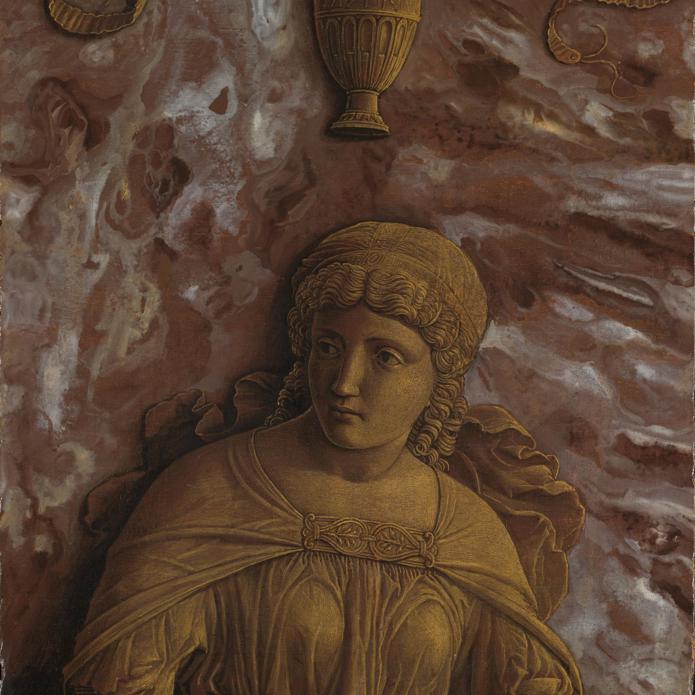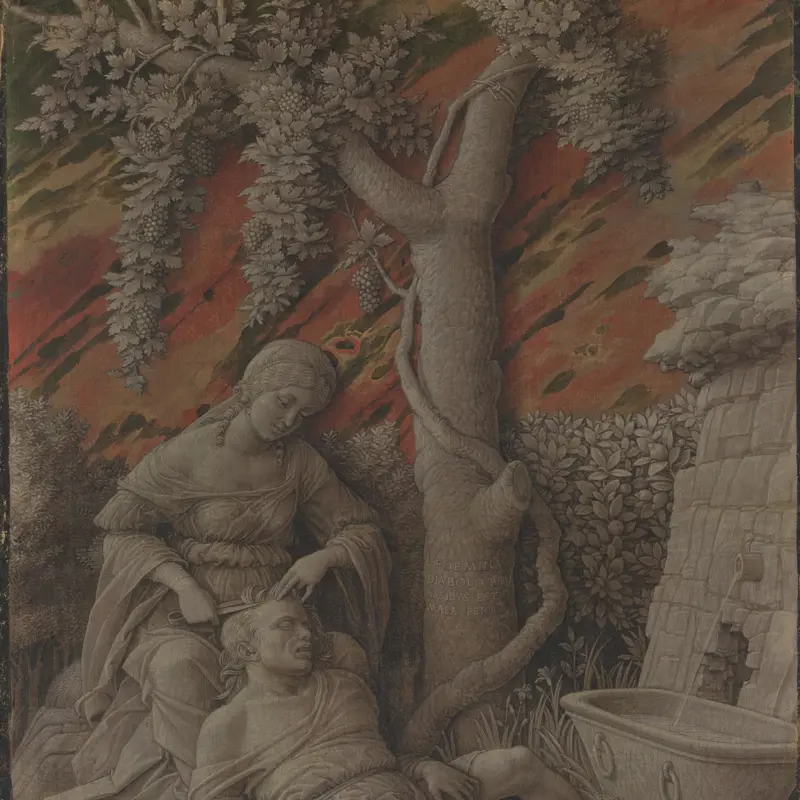Andrea Mantegna, 'The Vestal Virgin Tuccia with a Sieve', about 1495-1506
About the work
Overview
Taking careful steps, a woman comes towards us, holding what at first glance looks like a deep circular tray. She is the Vestal Virgin Tuccia and the object she carries is, in fact, a sieve.
Vestal Virgins maintained the fire in the temple of the chaste goddess Vesta in Rome. Their virginity was crucial, but Tuccia’s was challenged. In order to prove it, and knowing that she had divine assistance, she gathered water from the river Tiber in a sieve and carried it to the temple. She predicted – correctly – that none of it would be lost, and that this would prove her virginity.
Mantegna has painted her in imitation of bronze relief sculptures set against a marble background – he was showing that he could rival the work of sculptors by imitating their material so brilliantly. We know that his patron Isabella d‘Este had a ’feigned bronze' picture by Mantegna in her studiolo (study): it is possible that Tuccia was made for that location.
Key facts
Details
- Full title
- The Vestal Virgin Tuccia with a Sieve
- Artist
- Andrea Mantegna
- Artist dates
- About 1431 - 1506
- Part of the series
- Two Exemplary Women of Antiquity
- Date made
- About 1495-1506
- Medium and support
- Egg tempera on wood (poplar, identified)
- Dimensions
- 72.5 × 23 cm
- Acquisition credit
- Bought, 1882
- Inventory number
- NG1125.1
- Location
- Room 14
- Collection
- Main Collection
- Previous owners
- Frame
- 15th-century Italian Frame
Provenance
Additional information
Text extracted from the ‘Provenance’ section of the catalogue entry in Martin Davies, ‘National Gallery Catalogues: The Earlier Italian Schools’, London 1986; for further information, see the full catalogue entry.
Exhibition history
-
2018Mantegna and BelliniThe National Gallery (London)1 October 2018 - 27 January 2019
Bibliography
-
1951Davies, Martin, National Gallery Catalogues: The Earlier Italian Schools, London 1951
-
1986Davies, Martin, National Gallery Catalogues: The Earlier Italian Schools, revised edn, London 1986
-
2001
C. Baker and T. Henry, The National Gallery: Complete Illustrated Catalogue, London 2001
-
2024C. Elam and G. Rebecchini, Mantegna: The Triumphs of Caesar, London 2024
About this record
If you know more about this work or have spotted an error, please contact us. Please note that exhibition histories are listed from 2009 onwards. Bibliographies may not be complete; more comprehensive information is available in the National Gallery Library.
Images
About the series: Two Exemplary Women of Antiquity

Overview
Viewed from a distance these two small pictures look like little bronze sculptures set against a pink and white marble background. They were known as bronzi finti – fictive bronzes. Mantegna painted several images mimicking antique sculpture, reflecting his interest in the art of antiquity but also showing off his ability to rival the work of sculptors using just paint.
The woman holding the sieve represents Tuccia, a renowned Vestal Virgin (a priestess who maintained the eternal fire at the temple of the chaste goddess Vesta in Rome). The woman with a goblet could be Sophonisba, a Carthaginian ruler who drank poison rather than be taken into slavery by the Roman general Scipio Africanus. Both were celebrated in the work of the fourteenth-century Italian poet Petrarch.
Archaeological discoveries of ancient artefacts sparked new appreciation of the classical world among the aristocracy. Mantegna’s inventive imitation of classical-style artefacts would have appealed to his sophisticated patrons – the ruling Gonzaga family – in Mantua.
















